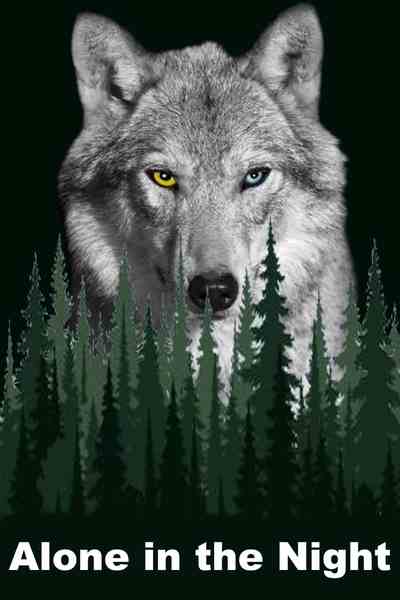Werewolves
How to become a werewolf?
There are two known ways of becoming a werewolf. First one is the most common way, where the lycanthropy virus spreads through another werewolf’s bite. Another way is to be born to parents who are both werewolves. This is extremely rare as female werewolves rarely give birth due to the transformations usually being too stressful for the body and the growing baby. Sometimes, when the baby is strong enough to survive through pregnancy stage, they are born as werewolves. However, the baby’s first full moon is usually fatal to them due to the painful and grueling transformations. If a werewolf and a human have a child, that child may have some wolf-like traits (e.g. unusual body hair growth, preference to raw meat or keener senses) but they do not transform during the full moon.
The characteristics of werewolves
Appearance
Most werewolves look like normal wolves but may be larger in size.
The colouration of wolves varies but usually it follows the human form’s natural hair colouration in some ways. Different markings are also possible. Eye colouration follows the human eye colour as well but may also be more animal like, yellow or orange, or in rare cases red. Eye colour may be the best sign of recognizing a werewolf since they can have eye colours that do not appear in normal wolves.
Scars, wounds and tattoos follow to the wolf form, as do the wounds from wolf transfer to the human body. Tattoos are always covered by the fur and do not affect the appearance of the wolf. Scars and wounds may be visible depending on the place and size of the scar.
It is almost impossible to recognize a werewolf in their human form since they rarely differ from normal humans in appearance. The best way to recognize them is to find their bitemark that is usually located in arms or legs.
Behaviour
Werewolves have an instinct to hunt and bite humans, meaning that they if they run into a human in their wolf form, they will most likely attack. However most don’t want to bite other people so they head to areas far away from people to spend the night. After biting their victim, most wolves usually leave them instead of killing them in order to spread the lycanthropy. However, it is not uncommon for a wolf to kill the human in the frenzy of hunting.
Even though werewolves are usually driven by their instincts to hunt and/or kill, their human side is usually at least somewhat aware of what happens in the wolf form, and vice versa. A good example of this is people having memories of the night they spend in their wolf form. This may also cause conflict where the human side is trying to intervene with what the wolf is doing or guide it. It is an extremely rare occurrence and usually possible only to those who have spent several years as werewolves and accepted their wolf side instead of despising it. Strong emotions may also be a catalyst to such an event, for example the wolf trying attack someone who is a close friend or a relative, may wake up the human consciousness to intervene.
Werewolves are highly social and seek the company of their kind. This happens in both human and wolf form and it is common for werewolves to live in groups or packs as they are usually called. The pack usually has an alpha and a beta but apart from that there is rarely any other hierarchy. Fights between werewolves are also very common, especially if a wolf crosses on another one’s territory.
It is usual that werewolves have only one mate. They may of course date several people but when after meeting their mate, they fully commit to them for lifetime. Usually the mate is another werewolf or at least is later turned into one either by their wish or due to an unfortunate accident where they get bitten. The unwritten rule between wolves is that other person’s mate is off-limits and breaking this rule may even lead to being driven off the pack they live in.
Abilities
In general werewolves are stronger and smarter than normal wolves. For example, they can run longer distances faster than normal wolf. It is also very difficult to kill a werewolf, since they have basically supernatural healing abilities. The most effective way to kill a werewolf is to use a silver weapon or poison/weaken them with wolfsbane.
Werewolves also have sharper senses, such as sense of smell and hearing, in both human and wolf form. They can also recognize fellow wolves when in human form.
While most werewolves only transform during the full moon, those that are born as werewolves can transform whenever they want to and also maintain the full control of their wolf. This also applies to wolves that live in packs but unlike born werewolves, they lose their ability if they leave the pack.
Living in a pack also gives wolves the ability to communicate by sharing their thoughts with each other in their wolf form despite the distance. This can be involuntarily as well, usually bursts of emotions may be relayed to others and younger wolves may have trouble controlling their thoughts at first. Leaving the pack makes the wolf lose this ability as well.
Weaknesses
Werewolf’s biggest weakness is silver. Touching silver burns their skin and is the best way to kill one as it poisons the wolf and stops their healing abilities from working.
Wolfsbane is another poisonous substance to werewolf. While only lethal in large amounts, it can poison the wolf and cause permanent damage.
Some werewolves suffer from extreme pains before the full moon, making them highly vulnerable and easily recognizable to those who know about werewolves.
In a way, full moon can be seen as their weakness even if it is an essential part of lycanthropy. Werewolf cannot hide from the moon and is bound to transform as the moon rises no matter where they are or what they are doing. The person can try to resist the moon by staying in a completely dark room but even then, it requires an excessive strength of mind to not give in. And even then, if the person manages to not transform there is a very high chance of serious mental or physical damage, such as increased aggressiveness, mood swings, or even random and uncontrollable transformations.
Reputation
Werewolves are generally considered to be creatures from fairy tales and even most authorities don’t know or believe in their existence. Werewolves as creatures are still generally feared although their portrayal in popular culture seems to have changed some peoples’ attitudes towards them.
There are also people who firmly believe in werewolves and even hunt them to stop them from spreading the lycanthropy virus. These people are still few and far between since the existence of werewolves has not been confirmed.
Monstrous werewolves
While most werewolves look like normal wolves, some appear more monstrous or human-like, resembling those depictions of werewolves in horror movies, and they are sometimes accordingly called “monster wolves”.
Since the monster wolf has taken a more human-like appearance, they usually have the ability to stand and even walk on two legs. They usually have five fingers and toes and shorter tail than a normal wolf. They may also have little to no hair in their body (or have as much as wolf normally would). Even as a human they have animal like traits like longer and sharper claws and teeth or more hair growth than normally.
This “advancement” to monster wolf only happens to werewolves that have spent a significant amount of their lives as werewolves and embrace their wolf side, following the wolf’s life style even in human form and giving in to their wolf.
While monster wolves are generally more intelligent than normal werewolves, they are also highly unpredictable and dangerous as they embrace their wild wolf side. They are still capable of rational thinking and are not necessarily as driven by their instincts if they wish not to be.
Monster wolves are usually more difficult to trap or kill in their wolf form since they are stronger and more intelligent but recognizing them is much easier, in both human and wolf forms.












Comments (2)
See all